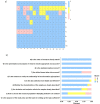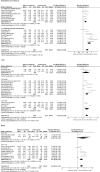Meta-analysis of the correlation between serum uric acid level and carotid intima-media thickness
- PMID: 33571245
- PMCID: PMC7877574
- DOI: 10.1371/journal.pone.0246416
Meta-analysis of the correlation between serum uric acid level and carotid intima-media thickness
Abstract
Objective: Recently, increasing epidemiological evidence has shown that there is a correlation between serum uric acid level (SUA) and carotid intima-media thickness (CIMT). This paper explored the relationship between them through meta-analysis.
Methods: PubMed, Cochrane Library, EMBASE, Web of Science and Google Scholar were searched to obtain literature. The keywords used to retrieve the literature were carotid intima thickness, intima-media thickness, carotid atherosclerosis, carotid stenosis, carotid artery, uric acid, blood uric acid, and hyperuricaemia. The retrieval time was from the establishment of the database through July 2020. Stata15.0 and RevMan5.3 software were used for statistical analysis. The standardized mean difference (SMD) and 95% confidence interval (95% CI) were calculated by a random effect model to estimate the correlation. Publication bias was assessed using the Begg and Egger tests. The stability of these results was evaluated using sensitivity analyses.
Results: Fifteen studies were included with a total sample size of 11382, including 7597 participants in the high uric acid group and 3785 in the control group, on the basis of the inclusion and exclusion criteria. According to the evaluation of the JBI scale, the literature was of high quality. The average age ranged from 42 to 74. Meta-analysis showed that CIMT in the high uric acid group was significantly higher than that in the control group (SMD = 0.53, 95% CI: [0.38, 0.68]), and the difference was significant (z = 6.98, P < 0.00001). The heterogeneity among the 15 articles was obvious (I2 = 89%, P < 0.00001). Subgroup analysis by disease status illustrated a positive relationship between SUA and CIMT in healthy people and people with diseases. SUA was shown to be positively correlated with CIMT in people aged 45-60 years and ≥60 years by subgroup analysis by age. SUA was also found to be positively correlated with CIMT in a population with BMI>24 kg/m2 by subgroup analysis by BMI. In addition, subgroup analysis of other risk factors for CIMT, including TC, SBP, DBP, triglycerides, and LDL-C, all showed a positive correlation between SUA and CIMT.
Conclusions: There is a significant correlation between serum uric acid level and carotid intima-media thickness, and a high concentration of serum uric acid is related to carotid artery intima-media thickness.
Conflict of interest statement
The authors have declared that no competing interests exist.
Figures






References
-
- Liu F, Du GL, Song N, Ma YT, Li XM, Gao XM, et al. Hyperuricemia and its association with adiposity and dyslipidemia in Northwest China: results from cardiovascular risk survey in Xinjiang (CRS 2008–2012). Lipids Health Dis. 2020;19(1):58 Epub 2020/04/03. 10.1186/s12944-020-01211-z - DOI - PMC - PubMed
-
- Chen-Xu M, Yokose C, Rai SK, Pillinger MH, Choi HK. Contemporary Prevalence of Gout and Hyperuricemia in the United States and Decadal Trends: The National Health and Nutrition Examination Survey, 2007–2016. Arthritis Rheumatol. 2019;71(6):991–9. Epub 2019/01/09. 10.1002/art.40807 - DOI - PMC - PubMed
Publication types
MeSH terms
Substances
LinkOut - more resources
Full Text Sources
Other Literature Sources

